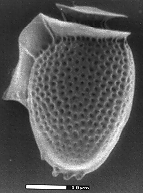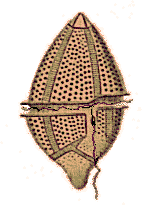








Dinoflagellates are surrounded by a complex covering called the amphiesma, which consists of outer and inner continuous membranes, and between which lie a series of flattened vesicles. In armored forms, these vesicles contain the thecal plates, cellulose plates that are the "armor". This armor may be lacking (the cells are "naked"), and some species shed their theca under certain environmental conditions.
Armored dinoflagellates have two major plate regions composed of two
to 100 individual plates. The edges of the plates overlap, sliding apart as the
cell increases in size and allowing the cell to expand. The plates come in
many varied shapes, from spherical forms like Peridinium to
elongate horn-like forms such as Ceratium. In addition, some
species have ridges or crests -- especially members of the Dinophysiales,
such as the one shown at right. In
some, the crests may be hollow and house cyanobacteria which provide
fixed nitrogen to the host. This is most common in nitrogen-poor waters.

The term "dinoflagellate" means "whirling flagella". In fact, each dinoflagellate has two flagella, long clusters of protein strands which can be manipulated for movement. The two flagella are of different sorts-- that is, they are constructed and move in different ways.
One flagellum lies in a groove, the sulcus that runs between the
thecal plates from the center of one side, to the posterior end of the cell.
When this posteriorly oriented flagellum beats backs and forth, it propels the
dinoflagellate in the opposite direction -- anteriorly. The other flagellum is
flattened and ribbonlike and lies in a groove, the cingulum, that
encircles the cell, dividing it into its two primary regions. This flagellum
allows the dinoflagellate to turn and maneuver, as well as providing forward movement. The combined action of these two flagella may cause the
dinoflagellate to slowly turn on its axis as it moves through the water, and
this is where the group gets its name.
The nucleus of the Dinoflagellata has many odd features unique to the group. The DNA does have repeated sequences like other eukaryotes, but does not seem to have histones (basic proteins which the DNA coils around) -- though reports vary as to whether or not basic proteins exist in the group. Dinoflagellates have more DNA in their nucleus than other eukaryotes, so much so that the nucleus often fills half the volume of the cell.
A single dinoflagellate may have 12 to 400 chromosomes in its nucleus. These are not scattered, but are attached to the nuclear membrane. Upon division, the nuclear membrane does not break down as in plants and animals, rather a "spindle" of microtubules develops in channels that permeate the nucleus, and coordinates the segregation of chromosomes. The chromosomes remain condensed during mitosis and even during interphase, though they do unwind for replication of the DNA.
This unusual nuclear situation is termed mesokaryotic in the
belief that it was transitional between prokaryotic and eukaryotic structure,
but it is now thought to be a uniquely derived feature of the Dinogflagellata.
Photosynthetic dinoflagellates have eyespots, light-sensitive organelles composed of lipid droplets packaged within stacked layers of membranes. These contain carotenoid compounds, which are light- excitable, allowing the organism to detect the direction of the light source. A few rare species have a more complex structure, the ocellus, which uses a refracting lens to focus a projected image on the retinoid lining membrane. Not bad for a unicellular critter!
Many dinoflagellates produce defensive trichocysts, often hundreds per cell. These are discharged upon rapid hydration, ejecting long rod-shaped protein filaments similar to those found in ciliates like Paramecium. The effect is much like an exploding can of spray-string.
In those dinoflagellates capable of photosynthesis, there is a triple-membraned plastid, which contains the photosynthetic machinery. This plastid may contain its own nucleus. (Click on the Systematics button to see more.)


